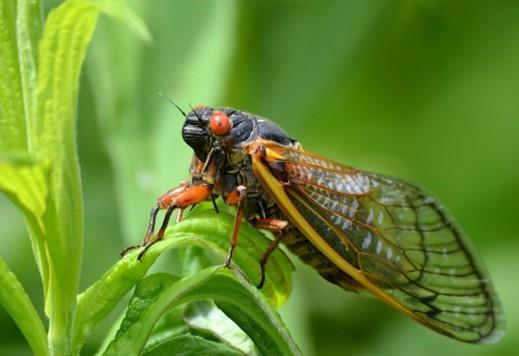Cicada Hordes Rely On Trees To Know When To Emerge
Cicadas count the years according xylem flows in the trees on which they feed as larvae.

As cicadas begin to emerge throughout the South and Midwest in the United States, Northwestern University’s Jorin Graham studies how these periodical broods synchronize their behaviors.
Graham is a Ph.D. student in physics at Northwestern’s Weinberg College of Arts and Sciences, where he studies complex networks and network science. He is advised by Dr. Adilson Motter, the Charles E. and Emma H. Morrison Professor of Physics and director of the Center of Network Dynamics. According to Graham, the synchronization and emergence of cicadas may temporarily disrupt the food web.
“Periodical cicadas spend years living underground before emerging together to briefly mate and die. The cacophony of their mating calls can be deafening. Upon hatching, cicada nymphs return to the ground and repeat the process. This curious behavior, in which billions of cicadas coordinate their behavior, is an example of synchronization," Graham said.
In June, seventeen states will see trillions of the bulbous-eyed insects in a double-brood emergence that happens only every 221 years. This year, because several broods of cicadas coincide, there will be untold numbers of cicadas more than average.
While there are more than 3,000 species of cicadas found in various parts of the world, they are grouped into the categories of annual and periodical. While annual cicadas appear every year and thus are heard and seen often, the periodical cicadas emerge either every 13 or every 17 years, according to their species. This year, the 13-year brood and the 17-year variety come at the same time. The two broods were hatched in 2007 and 2011, respectively, and have lived underground as larvae since then.
“The study of synchronization is itself rooted in physics, often considered to have originated with Dutch physicist Christiaan Huygens’ studies of pendulum clocks in the 17th century. Synchronization is now recognized as an important behavior across many domains — from engineered systems like power grids, to biological systems such as neuron firing in the brain, to other ecological phenomena such as the coordinated production of fruit by oak trees. Remarkably, such synchronized behavior is commonly achieved without centralized planning or enforcement," Graham said.
The following are the states that will see the cicada emergence: Illinois, Michigan Louisiana, Mississippi, Arkansas, Alabama, Georgia, Tennessee, Iowa, Maryland, Texas, Oklahoma, Kentucky, North Carolina, Virginia, South Carolina, Missouri, and Wisconsin. Peoria, Ilinois, has already seen the beginnings of the emergence.
Male cicadas make a racket to attract mates. They climb available trees, lamp posts, and telephone poles where they snchronize their mating calls. The season lasts approximately a month. Brood XIX and Brood XIII have waited for the appropriate soil conditions to come from underground to the surface. On most any available vertical surface, the bugs will eat, mate and die. Their nymphs, once hatched, drop to the ground to burrow their way down where they will start the cycle all over again
There will be a million of them per acre. They are not harmful to pets or farm animals. But they are loud enough to cause deafness should a cicada manage to get close to a human ear.
Cicadas are able to harm young trees. A net thrown over such trees during the mating season may protect them. Insecticides cannot kill enough of the bugs to make a difference, and will kill useful insects such as bees.
The last time there was such a convergence of broods was in 1803, when President Thomas Jefferson was in office. The offspring of the two broods will be seen again in 2037 and 2041 respectively, but will not coincide again until 2236.
“So how do periodical cicadas coordinate their emergence? Each individual cicada counts the passing years based on annual cycles of xylem flows, a nutritious fluid in trees on which they feed. Cicadas that are born the same year will emerge with the rest of their brood 13 or 17 years later. However, a few cicadas, known as stragglers, miscount and emerge too early or too late. If these cicadas reproduce, their offspring would also emerge out of cycle and, eventually, the periodic cicadas would lose synchronization. Synchronization is preserved by predators, such as squirrels, who quickly consume cicadas that emerge at the wrong time. During normal emergence years, so many cicadas come out that predators can’t eat all of them, allowing the remaining cicadas to reproduce, thus sowing the seed for the next coordinated emergence," Graham said.